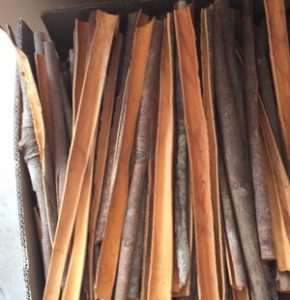
1. Origin and Growing Regions:
The cinnamon tree (Cinnamomum cassia) has been associated with Vietnam for a long time, mainly grown in the northern mountainous regions. However, the reputation of “Cinnamon” is particularly linked to the land of Yen Bai. This region has specific climatic and soil conditions that are ideal for cinnamon trees to thrive, resulting in thick bark, high essential oil content, and a distinctive flavor that is unmatched.
Besides Yen Bai, also grown in some other provinces such as Lao Cai, Tuyen Quang, and Quang Nam, but Yen Bai Cinnamon is still considered to have superior quality.

2. Nutritional Value and Health Benefits:
- Essential oil: The main component is cinnamaldehyde, which provides the characteristic aroma and many biological activities.
- Polyphenols: Powerful antioxidants that help protect cells from damage.
- Fiber: Supports a healthy digestive system.
- Minerals: Such as calcium, iron, and manganese.
Thanks to these components, Cinnamon offers many health benefits that have been researched and proven, including:
- Antibacterial and antifungal: Cinnamaldehyde can inhibit the growth of many types of bacteria and fungi.
- Anti-inflammatory: Helps reduce inflammation in the body.
- Blood sugar regulation: May improve insulin sensitivity and help control blood sugar levels.
- Cholesterol reduction: Some studies suggest that can help lower bad cholesterol (LDL) and triglycerides.
- Improved brain function: The aroma of may improve memory and concentration.
- Antioxidant properties: Polyphenols help protect cells from free radicals.

3. Export Market:
Has long established its position in the international market. With its superior quality and distinctive flavor, Cinnamon is a significant agricultural export commodity, bringing substantial foreign currency earnings to the country.
The main export markets for Vietnamese include:
- India: The world’s largest consumer of cinnamon, mainly used in cuisine and traditional Ayurvedic medicine.
- Middle East: Countries like the UAE and Saudi Arabia also have a high demand for cinnamon for use in cooking and as a fragrance.
- Europe and the United States: This market is increasingly interested in natural and health-beneficial products.
- Other Asian countries: Japan, South Korea, and Singapore are also potential markets.
4. Products Made from Cinnamon:
The diverse applications of Cinnamon have led to the creation of many different products, catering to the varied needs of the market:
- Bark: The most common form, used as a spice in cooking, tea making, and alcohol infusion.
- Sticks: bark rolled into sticks, often used in stews, soups, or as a garnish.
- Powder: convenient for seasoning, baking, and preparing beverages.
- Essential oil: Extracted from the bark, leaves, or branches of the tree, used in aromatherapy, massage, and the production of cosmetics and pharmaceuticals.
- Tea: Tea bags or pure cinnamon leaf tea, offering a warm flavor and many health benefits.
- Candies and cakes: Snack products with the characteristic flavor.
- Handicrafts: Cinnamon bark is also used to make decorative items and souvenirs with a strong Vietnamese cultural identity.
- Pharmaceutical ingredients: Essential oil and active compounds in used in some traditional medicines and healthcare products.
Products from Vietnamese coffee
Other news


